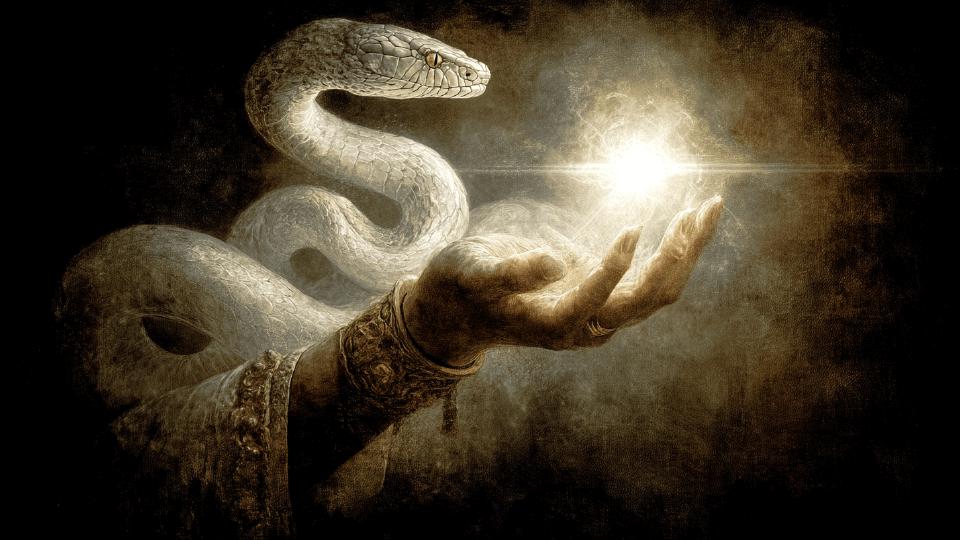
The katabasis unfolds as a sequence of dissolutions and revelations, each stage stripping away density and preparing for deeper empowerment. After the draining of the orange orb and the departure of the worms from the solar plexus, the field lies quiet but alert. The abdomen feels hollowed, yet not empty in weakness. Rather, it is like a chamber swept clean, waiting for what is to come. The emotional tone at this threshold is cautious relief and the stirring anticipation of a greater emergence.
The Serpent Shifts
The coiled serpent, which earlier had coursed within the subtle body and pressed toward the brow, undergoes a decisive transformation. No longer confined as an inner compulsion, it begins to externalize. The first sign is pressure rising from within, followed by a release outward. What had once been an inward force now appears beyond the body, crossing the boundary of flesh into vision. In Hermetic terms, this is the passage of inner fire into manifest form, a demonstration of how latent force becomes visible and directed when discipline has cleared the vessel.
The Serpent in Hand
The vision clarifies: the serpent is seen held in the hand. It is luminous, alive, responsive. Its presence is no longer overwhelming or compulsive; it is now accessible, available to be directed. The emotional tone shifts as well: from the sense of being ridden by a current to the recognition of mastery. What once pressed and burned within is now a companion at one’s side, waiting for command.
The symbolism here is rich. The serpent in hand echoes the Egyptian uraeus, the flame-crowned serpent of sovereignty placed upon the brow of pharaohs. It recalls the Chaldean “Father’s Fire,” once dangerous if unmastered, now a creative agent. It fulfills the theurgic teaching of Iamblichus, that the initiate must learn to wield daimons, never to be possessed by them. Franz Bardon, in his hermetic training, likewise instructs that elemental force projected through the hands must be mastered consciously, or else it overwhelms the magician. The serpent here is that same force, externalized and made obedient.
Meaning of Externalization
This stage marks a shift of agency. The serpent is no longer an inner compulsion but an implement of will. What was once endured is now wielded. Such externalization is not possible without prior purgation. The orb and worms had to be expelled, enthronement had to be endured, before the serpent could be grasped without harm. Paracelsus warned that astral parasites must be cleansed before any projection of force, and Lévi described how larvae of the astral light distort power until banished. Only a cleared field can carry such potency without distortion.
The Watcher at the Brow
Yet not all serpentine fire is externalized. One serpent remains linked to the brow, stationed as the Watcher. This dual presence suggests differentiated roles within a single current. The hand holds the serpent of action; the brow retains the serpent of vision. Together they form the dual governance of the adept: oversight from above, operation from below. In this way, clairvoyant vision and operative force remain conjoined, ensuring that action is never severed from divine surveillance.
Emotional and Somatic Tone
The somatic impression is one of transparency. The body feels less like a vessel of energy and more like a channel. The emotions mingle awe with responsibility. Power has shifted form, but it carries a weight. The serpent in hand is not only a gift but a charge, to be used in alignment with the order that released it.
Symbolic Reading
- Externalization: the transition from passive initiation to active operation.
- Serpent in Hand: primal energy mastered, available as a magical implement.
- Watcher Serpent: ongoing oversight and divine attention.
- Katabasis Function: descent not only purges but equips.
Cross-Traditional Resonances
The Egyptian pharaoh bore the uraeus as a crown of fiery sovereignty. The Chaldean tradition warned that ophidian fire must be mastered lest it burn the unprepared. Mithraic rites depicted serpents coiling around altars, transmuted into sacred powers once enthroned. Bardon emphasizes the outward projection of elemental currents, while Carroll in modern chaos magic speaks of liberating raw force only when the psyche is balanced. Each tradition affirms the same truth: serpentine fire, once externalized and wielded, becomes the mark of sovereignty and the tool of creation.
Toward the Next Stage
Yet this externalization is not the final state. The serpent, held now in hand, foreshadows a return. It will not remain separate, for its destiny is reintegration. Soon it will dissolve again into the field of light, merging not as compulsion but as integrated companion. The arc of katabasis continues: purge, wield, and finally absorb.
The closing image lingers: the serpent resting in the hand, silent, luminous, waiting. No longer a pressure within, it stands as ally. Its gaze is watchful, its stillness a promise. What has been externalized will return, but it will return on new terms.